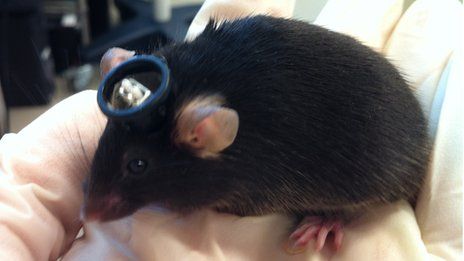Scientists have created a false memory in mice by manipulating neurons that bear the memory of a place. The work further demonstrates just how unreliable memory can be. It also lays new ground for understanding the cell behavior and circuitry that controls memory, and could one day help researchers discover new ways to treat mental illnesses influenced by memory.
In the study, published in Science on Thursday, the MIT scientists show that they can modify a memory and have a mouse believe it experienced something it didn’t. Susumu Tonegawa, a neuroscientist at MIT, and members of his lab used mice that were genetically modified to allow for certain neurons to be activated with a flash of light; the technique enabled the researchers to activate a memory that caused a mouse to believe it had experienced electrical shocks in a particular box, even though no such thing had happened there. “The process of memory is nothing like a tape recording,” says study co-first author Steve Ramirez. “It’s really malleable and susceptible to the incorporation of new information.”
The results are “really mind-blowing,” says Sheena Josselyn, a neuroscientist at the Hospital for Sick Children in Toronto. “It shows that your memories are really just activities of different cells, and they can take the place of an actual thing that happened by just activating some cells in the brain,” she says. “People have been playing around with this idea for a while, but having a theory and showing it are two different things.”
Advances in neuroscience methods and technology are giving researchers an unprecedented understanding of the biological basis of memories. In recent years, researchers have uncovered details about the molecular and cellular components of memory creation and the electrical language that cells use to recall memories (see “Making Memories” and “A First Step Toward a Prosthesis for Memory”).
More broadly, neuroscientists are increasingly exploring human cognition at its molecular and cellular origins. Someday, this deeper understanding could lead to better or novel treatments, such as memory implants that replace lost memories (see “Memory Implants”) or novel drugs to boost beneficial memory reconsolidation.
Previously, the MIT-based team had shown that it could pinpoint the location and assemblage of cells that carry a memory, and that activating those cells stimulated memory recall in mice. To create the new, false memory, Tonegawa’s team reactivated a mouse’s memory of a safe place while the animal received shocks in its feet, thus transforming the original memory.
First, the team used genetic tricks to label the brain cells involved in the memory of a chamber that was safe and neutral. The next day, they put the animal in a second chamber, a completely different setting. There, the animal got foot shocks while the researchers simultaneously shone light to reactivate the memory of the harmless first chamber. When the animal was put back in the first chamber, it fearfully froze—a clear indication that it remembered getting shocked in that chamber, even though that never happened. “It formed a false memory,” says Ramirez.
One of the long-term goals for the work is to be able to identify new methods for helping patients with cognitive disorders. “It’s not because we want to implant or ‘incept’ some false experience into the human mind, but because it could be useful, eventually, to develop methods to reduce cognitive abnormalities associated with psychiatric diseases, such as the delusions experienced by patients with schizophrenia,” says Tonegawa.
The work also explores the cellular and circuit-level mechanisms of memory. A different collection of neurons in the hippocampus was activated for the memory of the two different chambers. The team also found that not all regions of the hippocampus are created equal—the technique worked in one subregion but not another, which hints at different roles for the subregions in the steps of creating and processing memories, says Ramirez.
The way the false memory is formed in the mouse is basically the same cellular mechanism serving real memories, says Tonegawa, which explains why people with false memories can be so convinced that they are correct. “Human memory can be very unreliable,” says Tonegawa. “In legal settings, testimony based on memory should be considered with much less weight.”
Josselyn agrees that the results imply that false memories are not as uncommon as many think. “At some point, we shouldn’t really trust our memories, because some things we remember happening didn’t really,” she says. This new study shows that thinking about a memory isn’t even necessary to change it. “You can just activate the cells,” says Josselyn.
Future steps will be to use the technology of memory manipulation to try to fix unwanted aspects of brain function, such as depression and anxiety, which are both characterized by the intrusion of unwanted memories or an inability to associate positive feelings with memories. The direct manipulation of memories in humans would require new, less invasive technologies, because the optogenetic techniques employed in the study require virus-mediated genetic modification of neurons and a surgically implanted light source.
But researchers hope that some findings from the study could eventually be applied to help people. “If we can truly edit a memory, maybe we can edit it for the benefit of a patient,” says Ramirez.
Story Source:
The above story is based on materials provided by technologyreview, Susan Young on July 25, 2013





